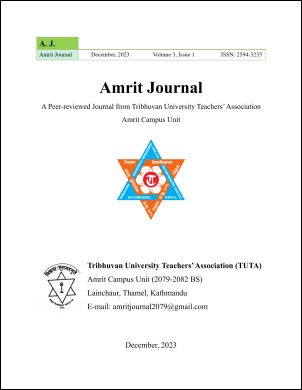Green Synthesis of ZnO/CuO Nanocomposite Using Punica granatum for the Enhanced Photocatalytic Performance
DOI:
https://doi.org/10.3126/amritj.v3i1.61537Keywords:
Dynamic light scattering, ZnO/CuO, Punica granatum, nonocomposites, 4-nitrophenolAbstract
Zinc oxide nanoparticles (ZnO NPs) and zinc oxide/copper oxide (ZnO/CuO) nanocomposites were constructed via green-synthesis route involving the use of Punica granatum seed extracts through microwave method. The as-synthesized samples were investigated for their catalytic activities. The fabricated nanomaterials were characterized using UV-visible spectroscopy (UV-vis), X-ray diffraction (XRD), Energy dispersive spectroscopy (EDS), Dynamic light scattering (DLS) spectroscopy, Field emission scanning electron microscopy (FE-SEM) and high-resolution transmission electron microscopy (HR-TEM). The peak observed at 385 nm in the surface plasmon resonance of ZnO NPs suggests the formation of nanoparticles of different sizes. The successful synthesis of composite was inferred from the shifting of UV-vis absorbance peak. Furthermore, the band gap energy of ZnO/CuO (with 10 wt.% of CuO precursor) was obtained to be 2.52 eV which was found lesser than that of nanoparticles. Phase morphology studied via XRD revealed the nanoparticles of crystalline nature. The mean crystallite size of extract mediated ZnO NPs and ZnO/CuO nanocomposites were found to be 61.5 and 53 nm, correspondingly. Similarly, morphological analysis of as-synthesized nanoparticles via HR-TEM showed the irregular to roughly spherical shape with size 100-200 nm. Nanomaterials generated in this manner were employed for the catalytic reduction of toxic 4-nitrophenol. The ZnO/CuO (with 10 wt.% of CuO) nanocomposites showed the higher degradation efficiency towards reduction of 4-nitrophenol compared to ZnO/CuO (5 wt.%) nanocomposites.
Downloads
Downloads
Published
How to Cite
Issue
Section
License
Copyright (c) 2023 Jenuka Tamang, Kamal Prasad Sapkota, Santu Shrestha, Sharmila Pradhan

This work is licensed under a Creative Commons Attribution 4.0 International License.
This license enables reusers to distribute, remix, adapt, and build upon the material in any medium or format, so long as attribution is given to the creator. The license allows for commercial use. Credit must be given to the creator.




